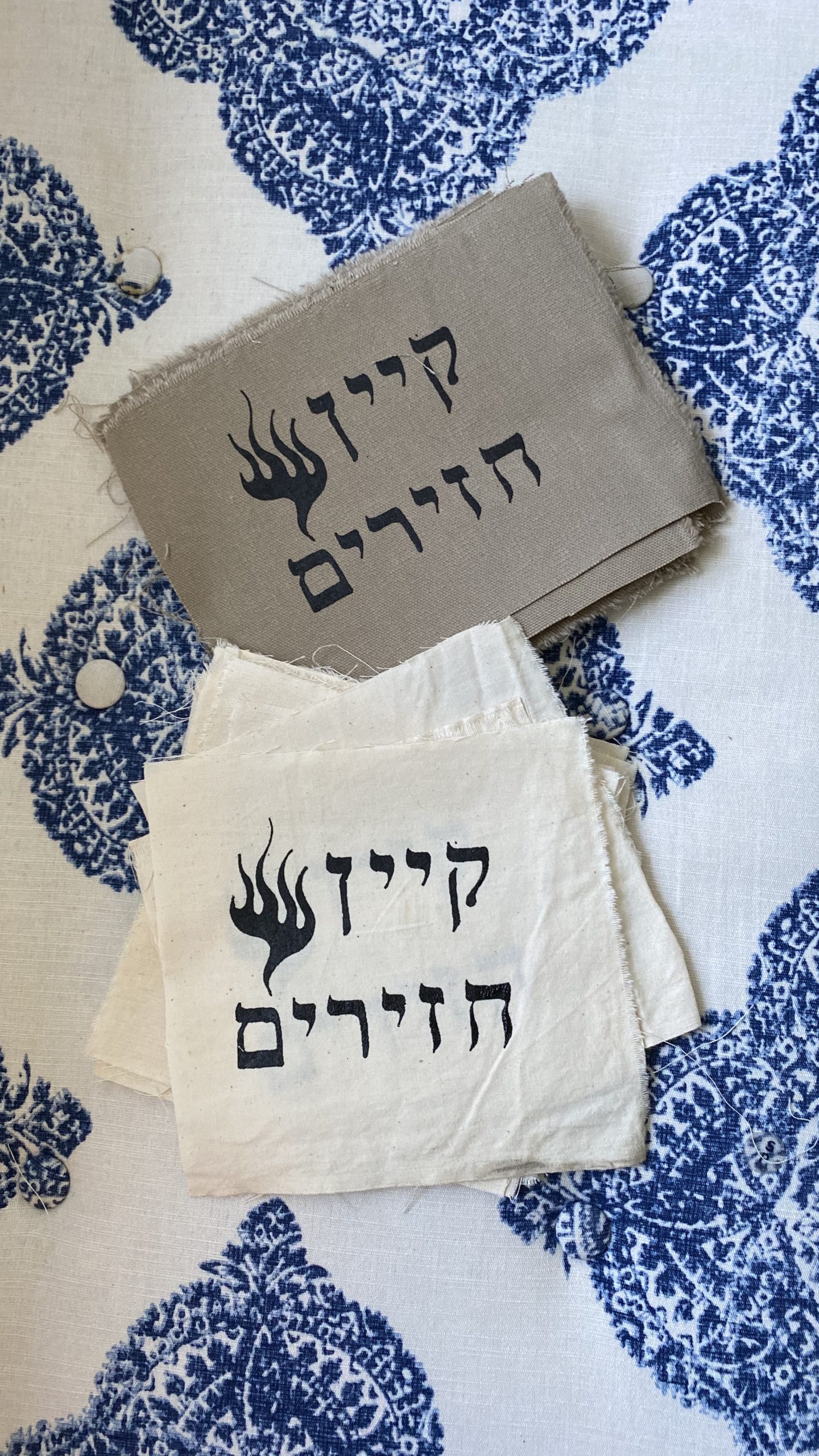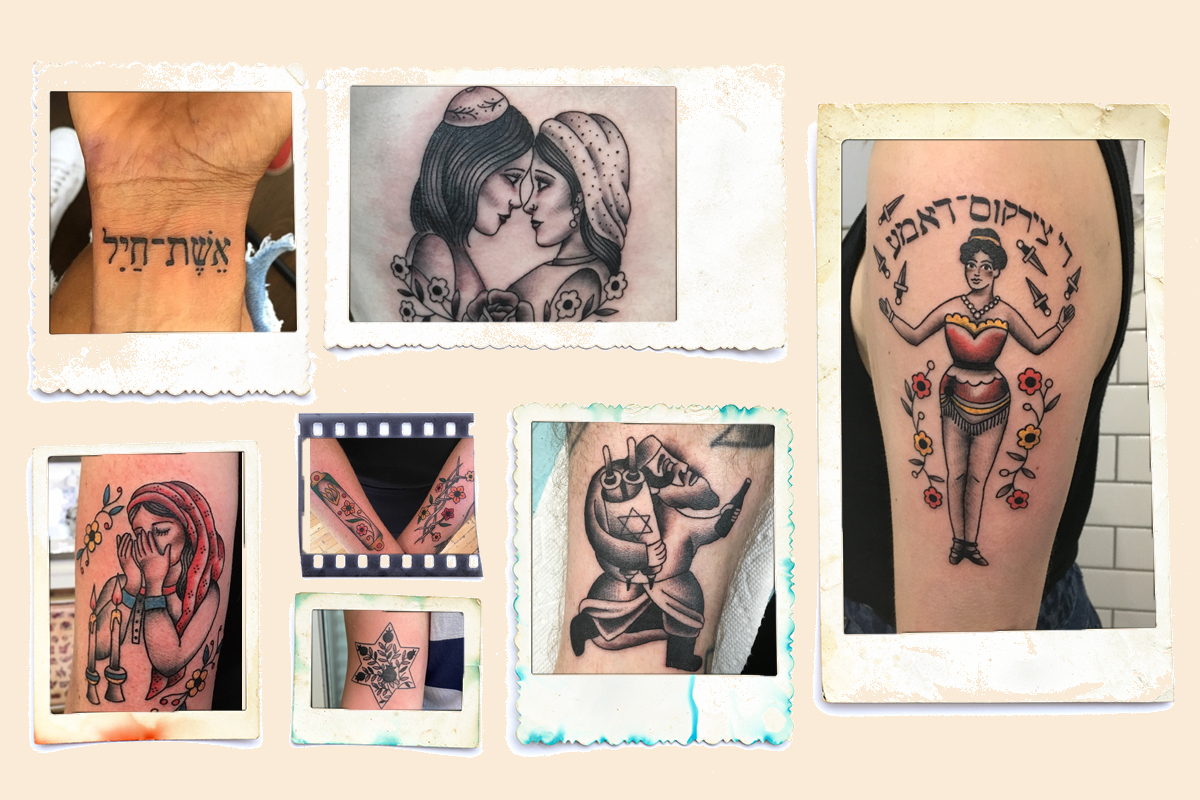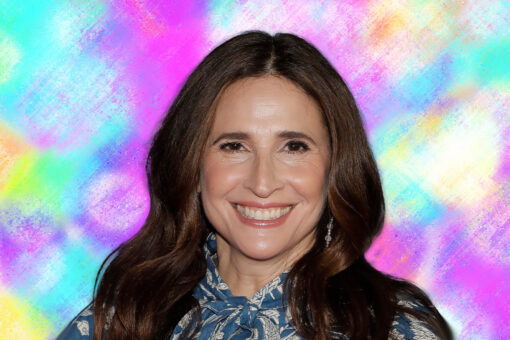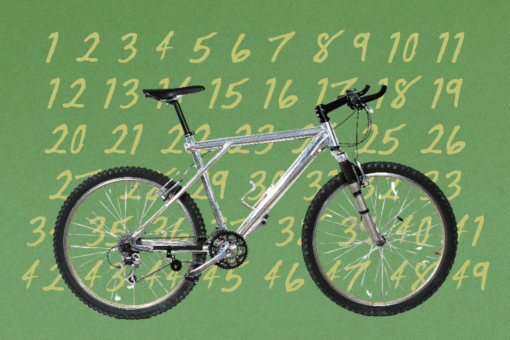Joey Ramona has the Hebrew letter shin tattooed on the middle of their forehead. For the Toronto-based tattoo artist, traditional Jewish imagery is so intertwined in their work that they quite literally display it as a symbol upon their face. Joey has been working in tattoo shops since they were 18. Now 34, Joey has been challenging stereotypes about what it means to present as a proudly Jewish person their entire life. I talked with Joey over the phone in August to discuss their life as a queer, feminist, Jewish tattooer.
This interview has been condensed and lightly edited for clarity.
How and when did you get into tattooing?
I started working in a tattoo shop when I was 18. I applied to a desk position and they gave me the job, which is really shocking. I was really inexperienced. I think I had like one tattoo at the time, but I started working there doing reception, and after spending a couple months doing that, I realized tattooing would be the perfect career for me because I love art and I love people. I basically begged the owner for literally years to teach me how to tattoo and eventually he said yes. So that’s how it started.
I love stories where you apply to one job and then that works out as your life.
Absolutely, it felt very serendipitous. I had previously planned to go work at a summer camp, which is very Jewish, and I applied to this job kind of as a whim and ended up getting it, so I canceled my summer camp plan, and my life completely pivoted.
What inspiration do you draw on in your art and tattoos?
Currently I’m really inspired by the political socialist movements of 1930s Europe, like the Bund Movement. I’m doing a piece right now, a painting that says “hey, hey, fuck the police” in Yiddish, and that comes from a political movement pre-Holocaust. But in terms of some of my more specific designs, I take a lot of my inspiration from Judaica, like ketubahs or my family’s haggadah. There are a lot of really beautiful graphics in these objects, so I tend to pull a lot of the floral motifs that I draw from those things.
Do you speak Yiddish?
No. I’m learning! My great-grandfather only spoke Yiddish, and my grandfather’s first language was Yiddish, so little bits and pieces have trickled down, and a lot of people like my mom and my aunts and uncles use Yiddish words really casually. It wasn’t until a few years ago that I started to really dig into that, and I was really excited to find that my mom actually knows more Yiddish than I thought, and she’s been helping me translate some of my paintings.
You recently posted a tattoo of Judith beheading Holofernes. Can you tell me more about how your art specifically draws on radical Jewish aesthetics?
I look for inspiration for images like that in a really deliberate way, because I do see Judaism as this platform for radical movements. I take a lot of my artistic influence from those movements. The story of Judith is very, very old, obviously, but when I imagined it in a contemporary context, I felt like it was still really applicable and really powerful.
When you imagine the story of Judith in a contemporary context, are you literally imagining “what would this be like to perform a political beheading that involves a seductress” or are you looking at it more abstractly?
A little bit more abstract. I’m thinking about it from a feminist context, using something that may be seen as oppressive to subvert and make powerful, like the way that she seduced him and cut his head off. Even though I cannot advocate for beheading, I think if you don’t take that so literally, it can be a really powerful statement in terms of how women and non-binary folks are perceived and how they can subvert that into a powerful movement.
I feel like that mirrors getting art on your body.
Yes, totally, and that’s also a big part of what motivates me to do what I do. I feel like Jews are often told that we shouldn’t get tattoos, and there are a myriad of reasons for that, but I think that it can be really powerful to reclaim that autonomy and say “actually, I want this and I’m putting this on my body in a really deliberate way.”
Obviously anyone who grew up in or near a Jewish community knows that tattoos are a whole conversation. Do you find yourself regularly having to navigate that conversation?
Yes. It’s a little bit more nuanced when I hear it from other Jewish people, but people who are not Jewish I find it’s like the first thing they go to because they don’t actually know that much about Judaism. So I get the same thing over and over: “I heard you can’t be buried in a Jewish cemetery.” I’ve had this discussion so many times.
That’s not really what it’s about for me. There are a few aspects to the practice that I think about, one being that our culture is centered around God and existing in the world as we are created, so the job that I do, my career, is part of who I am, and I don’t think that I should have to forgo that because of some archaic rules. Also, tattooing was used [in the Holocaust] to basically reduce the identity of Jews to a number. I think what I’m doing now is an attempt to subvert that, and putting Jewish images on your body permanently is a way of saying, “actually yes, I am Jewish. I’m not a number. I’m a person with all these different faucets, and I’m proud of who I am. And I’m proud of my Jewish identity.”
That’s really beautiful. I love taking the concept of B’tzelem Elohim, being made in the image of God, and asking, well, what does it really mean if I am made in the image of God?
Exactly, it’s so much more complex than [the narrow understanding]. And in Judaism, we focus more on the life that we live on Earth rather than our afterlife and where we are going to be buried.
Can you tell me more about your Jewish background and relationship to Judaism?
My mom is Jewish and my dad isn’t. My dad is an immigrant from Northern Ireland. My mom and dad eloped when they got married because my Jewish grandparents initially were very upset, but they’ve completely come around since. My mom was raised in a pretty traditional Ashkenazi household, and even though they weren’t necessarily very religious, the cultural aspects of Ashkenazim are very obvious to me in my own family dynamics.
My great-grandfather moved to Canada from Poland after a pogrom. As is the case with a lot of Jewish people, it’s been really hard to find a lot of information about where he lived. He came here but the rest of his family stayed and they perished. We were able to trace one great-great-uncle back to Poland, and his last known address was Auschwitz, but he escaped, which is pretty remarkable, so a lot of my artistic practice draws on my experience as an Ashkenazi person and an exploration of my family history that I sometimes imagine because I have to fill in the blanks somehow.
Shifting gears to right now, how has the COVID-19 pandemic changed your business and your focus as a tattoo artist and activist?
It’s been a journey. Not being able to work has forced me to reexamine my identity as a person and my relationship to tattooing, and that’s been a little bit difficult. However, I took it as a challenge. How can I use what I already know to continue to put these ideas out into the world? I was able to pivot and I made patches that said “kain chazarim,” which means “no pigs.” I’ve been selling those and donating the proceeds to local organizations in Toronto.

But going back to tattooing has been really great. Ultimately, it is my favorite medium to work in, and I’ve picked up where I left off in terms of doing Jewish tattoos, so the fact that I have to abide by certain safety protocols is just something I’m getting used to and don’t mind doing as long as I can keep doing what I was doing before.
I’ve seen you post a lot recently about racism in tattooing, can you elaborate more on this conversation and why it’s important?
Contemporary tattooing as we know it now is colonized. It was taken from Indigenous people and the people who created these rituals were told they weren’t allowed to do it anymore. These conversations have been coming up in the context of the greater conversation of anti-Black racism. Tattooing is no exception. It’s steeped in white supremacy, and as a white person with privilege, I was able to sort of float through for a little while without the awareness of it.
From following and getting to know the work of Black tattooers, and learning from the conversations they’ve started about white supremacy in our industry, it’s really opened my eyes in terms of making my practice safer, more inclusive, and equitable. There are so many amazing Black tattooers like Jalen Frizzell, Vegas, Doreen Garner, and Tann that are doing this work, and I’m trying to center their voices in the conversation.
What are the first things you’d like to see change in the tattoo industry at large?
Tattooing functions like a microcosm of the greater issues in society, so within our industry, white supremacy is obviously part of the creation of the contemporary tattoo industry. In order for that to change it needs to be smashed apart, and we need to break down all of these old tropes about who “deserves” to tattoo, who has access to tattooing, what tattoos are considered good and bad, what good and bad actually means.
All images in header courtesy Joey Ramona.



